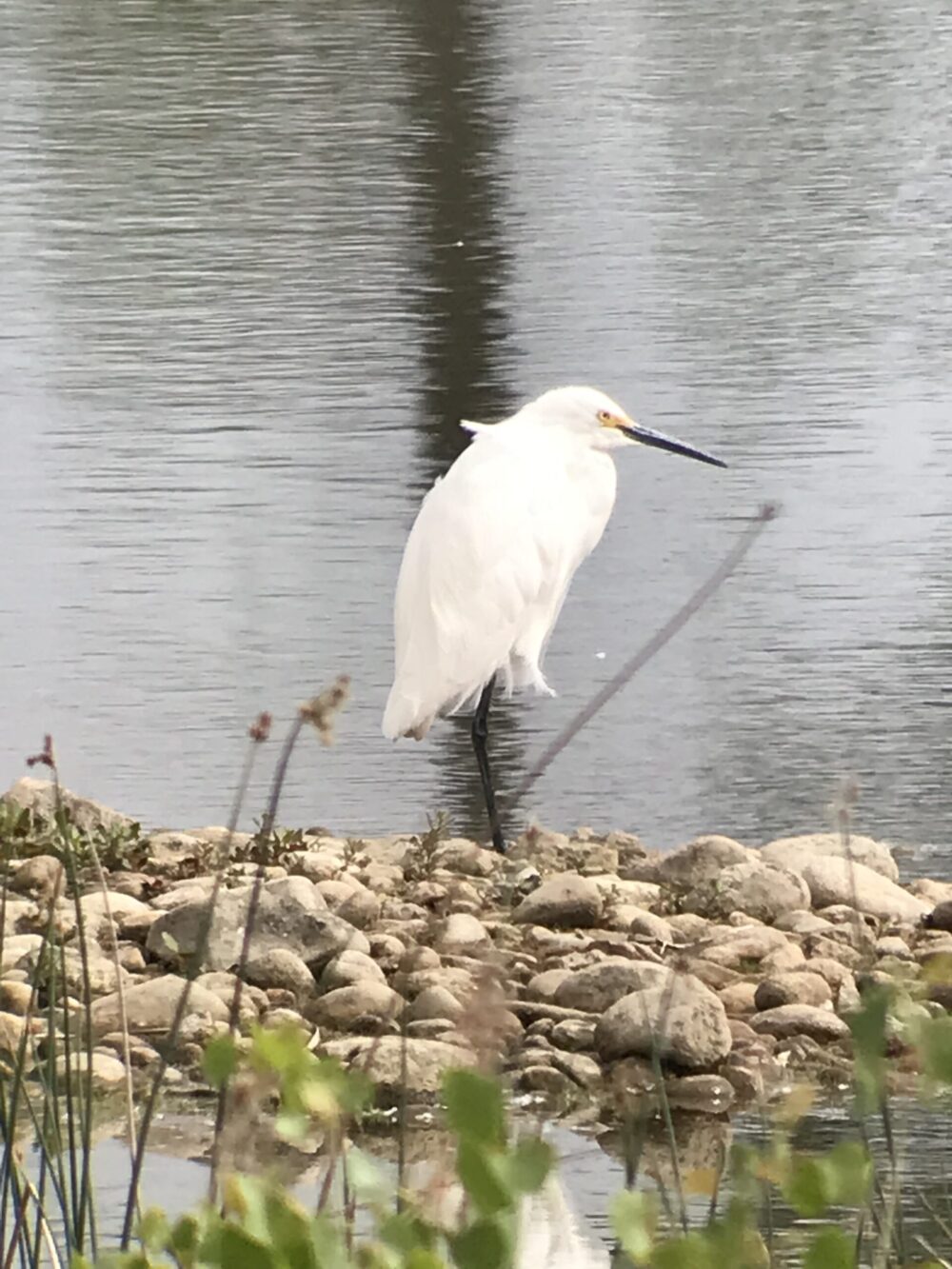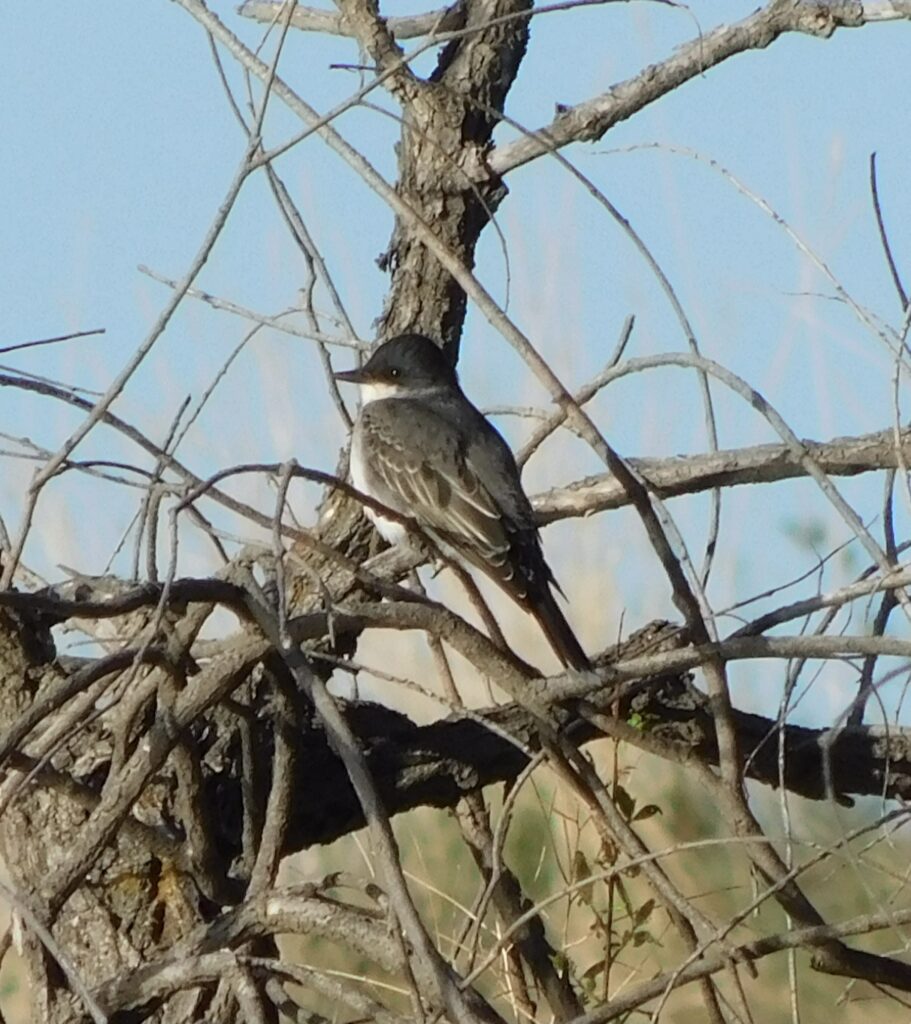The bird walk on June 7 was at Sawhill Ponds, a City of Boulder property. The former gravel mines turned wetland ponds offer great year-round birding opportunities. The summer breeding season brings many migrants to the area looking for good nesting spots and plenty of insect prey. With the sun rising earlier this time of year, we met around 7:30 am to get a glimpse of the birds before the heat of the day began.
We set off heading west along the main path that goes around the perimeter of Sawhill Ponds. The first part of our walk offered brief glimpses at Yellow Warblers, Bullock’s Orioles, and plenty of Red-winged Blackbirds. With the leaves on the trees fully grown out at this point in the season, it can be pretty difficult to spot a bird, even one as bright as a Bullock’s Oriole. Often we would have to rely on our hearing and knowledge of the various bird songs. The Merlin Bird app and its sound recognition feature works very well for one who is not too accustomed to the different songs and can help immensely in learning them.

After working out some of the different songs, we stopped by one of the first ponds north of the trail, which is officially called Sawhill Pond No. 3. Here we got some good looks at a Snowy Egret, which has been hanging out at this pond for the past couple of weeks. Our patient watching was even rewarded by catching a glimpse of the bird catching a fish! As we stood there watching the Egret, a Great Blue Heron swooped in, along with a pair of Spotted Sandpipers and Killdeer. These shorebirds are some of the few that stick around here for the summer, as most species of shorebird head to the far north to breed.
Farther down the trail, a pair of Eastern Kingbirds caught our attention. Kingbirds are easy to spot around here, for they often perch out in the open on a mullein stalk or branch, and from there they sally forth to catch a passing insect. As we watched the Kingbirds, a seemingly endless stream of bird song caught our attention. This song belonged to the Gray Catbird, a somewhat non-descriptive looking bird but one with lots of personality. Catbirds belong to the mimid family, a group of birds that are known for their ability to imitate other songs and even man-made noises. We were also able to hear the Catbird’s cat-like “mew” call, which is how they received their common name.

Near the singing Catbird, we stopped to view the Osprey nesting platform. Osprey have taken advantage of the numerous fish-stocked ponds that have been built over the years and can be found all over Boulder County. This mated pair seemed to be doing especially well, for we spotted two (maybe three) nestlings sitting with their parents.
We attempted to complete the perimeter loop, but as we neared the cottonwood grove on the western edge of the property, we were met with obnoxious noise from nearby gravel mining as well as hordes of mosquitoes. Make sure to bring plenty of bug spray if you head to this part of the trail! Instead, we headed back the way we came to head back to the trailhead. On the way we were stopped by a singing Common Yellowthroat. These birds can be very difficult to spot, as they like to stay hidden amongst the cattails. While attempting to spot the singing bird, we heard a different call, which was unlike any other bird we had heard. Much to our delight, it was Virginia Rail! These are very secretive birds that rarely leave the cover of the cattails, but some of us were lucky enough to spot this one. Our patient watching was rewarded even further by a glimpse of the singing Yellowthroat.
Sawhill Ponds is a Boulder birding gem that offers great chances to see a multitude of species (over 200 recorded on eBird). If one is willing to rise early on a summer day, brave the hordes of mosquitoes, and the noise from planes and construction, you will be rewarded with some of the best birds Boulder County has to offer.
Taxa
Canada Goose
Wood Duck
Mallard
Mourning Dove
Virginia Rail
Killdeer
Spotted Sandpiper
Great Blue Heron
Snowy Egret
Turkey Vulture
Osprey
Northern Flicker
Eastern Kingbird
Northern Rough-winged Swallow
Barn Swallow
House Wren
Gray Catbird
American Robin
Cedar Waxwing
Song Sparrow
Bullock’s Oriole
Red-winged Blackbird
Brown-headed Cowbird
Common Yellowthroat
Yellow Warbler


I wish I’d known that you were planning a trip to Sawhill Ponds. I’m the Ecosteward for the area. I know where most of the birds are nesting and could have helped with the bird songs.
There’s a Cooper’s Hawk nesting in the north end of the woods. Even if you had mosquito repellent, you probably wouldn’t have seen many birds!